brakes YAMAHA BANSHEE 350 2006 Notices Demploi (in French)
[x] Cancel search | Manufacturer: YAMAHA, Model Year: 2006, Model line: BANSHEE 350, Model: YAMAHA BANSHEE 350 2006Pages: 400, PDF Size: 3.59 MB
Page 204 of 400
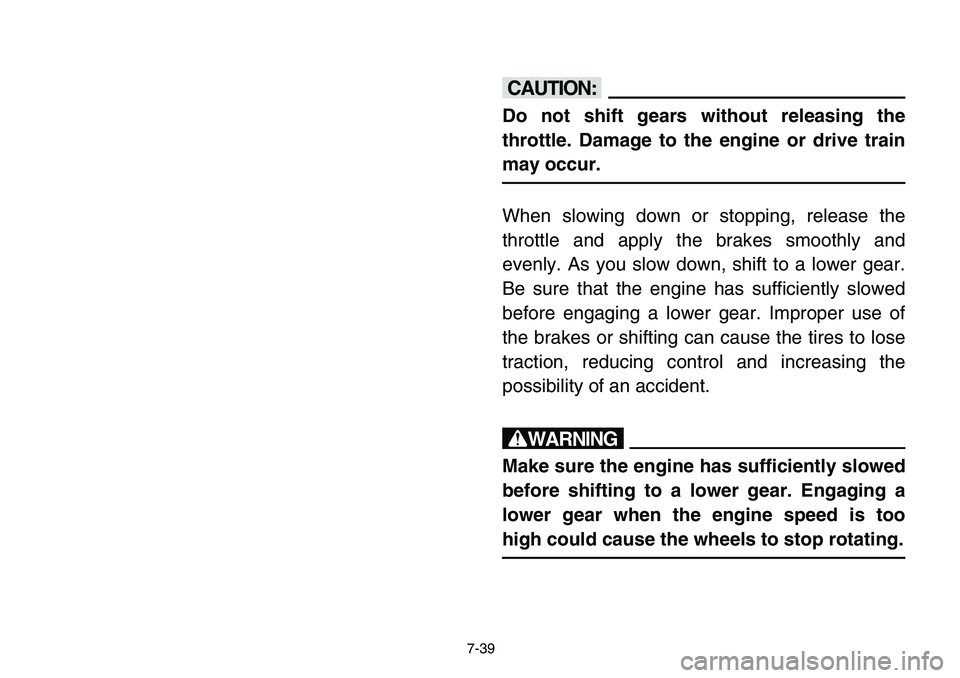
7-39
cC
Do not shift gears without releasing the
throttle. Damage to the engine or drive train
may occur.
When slowing down or stopping, release the
throttle and apply the brakes smoothly and
evenly. As you slow down, shift to a lower gear.
Be sure that the engine has sufficiently slowed
before engaging a lower gear. Improper use of
the brakes or shifting can cause the tires to lose
traction, reducing control and increasing the
possibility of an accident.
w
Make sure the engine has sufficiently slowed
before shifting to a lower gear. Engaging a
lower gear when the engine speed is too
high could cause the wheels to stop rotating.
Page 220 of 400
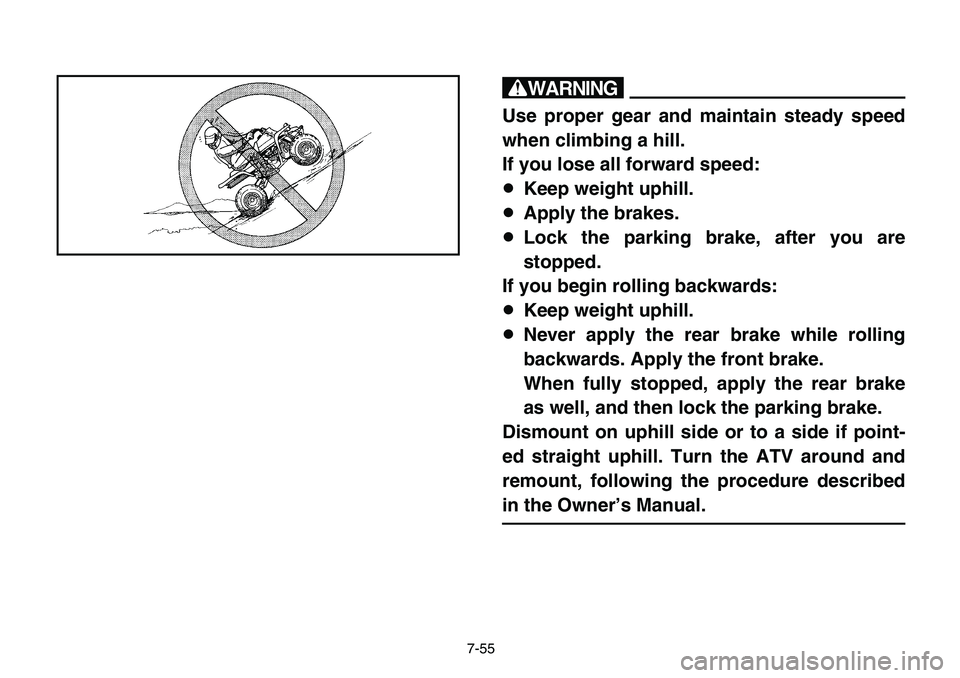
7-55
w
Use proper gear and maintain steady speed
when climbing a hill.
If you lose all forward speed:
8Keep weight uphill.
8Apply the brakes.
8Lock the parking brake, after you are
stopped.
If you begin rolling backwards:
8Keep weight uphill.
8Never apply the rear brake while rolling
backwards. Apply the front brake.
When fully stopped, apply the rear brake
as well, and then lock the parking brake.
Dismount on uphill side or to a side if point-
ed straight uphill. Turn the ATV around and
remount, following the procedure described
in the Owner’s Manual.
Page 230 of 400
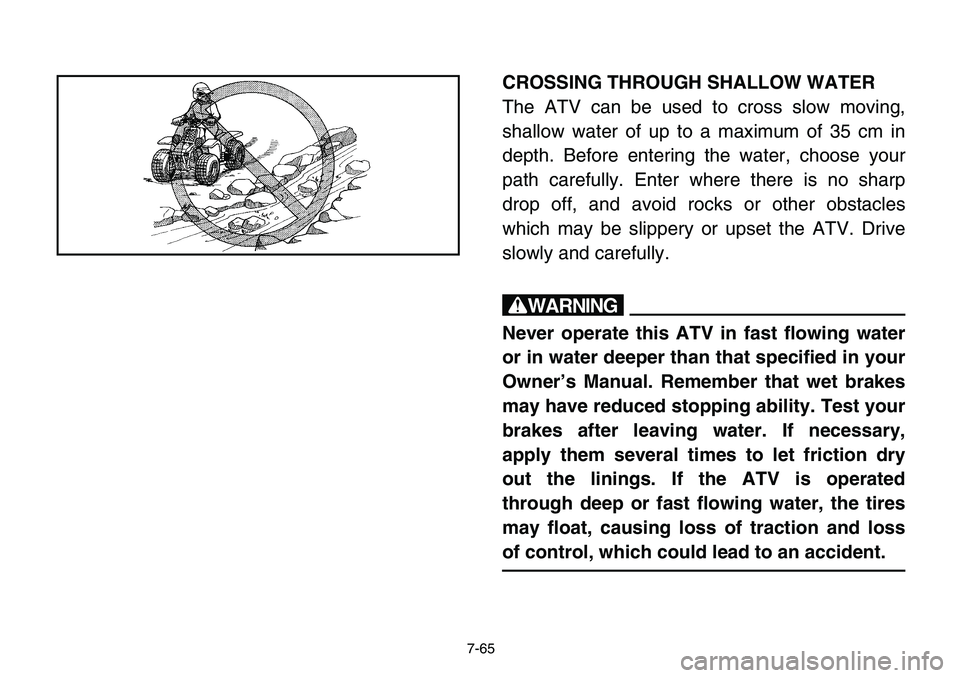
7-65
CROSSING THROUGH SHALLOW WATER
The ATV can be used to cross slow moving,
shallow water of up to a maximum of 35 cm in
depth. Before entering the water, choose your
path carefully. Enter where there is no sharp
drop off, and avoid rocks or other obstacles
which may be slippery or upset the ATV. Drive
slowly and carefully.
w
Never operate this ATV in fast flowing water
or in water deeper than that specified in your
Owner’s Manual. Remember that wet brakes
may have reduced stopping ability. Test your
brakes after leaving water. If necessary,
apply them several times to let friction dry
out the linings. If the ATV is operated
through deep or fast flowing water, the tires
may float, causing loss of traction and loss
of control, which could lead to an accident.
Page 232 of 400
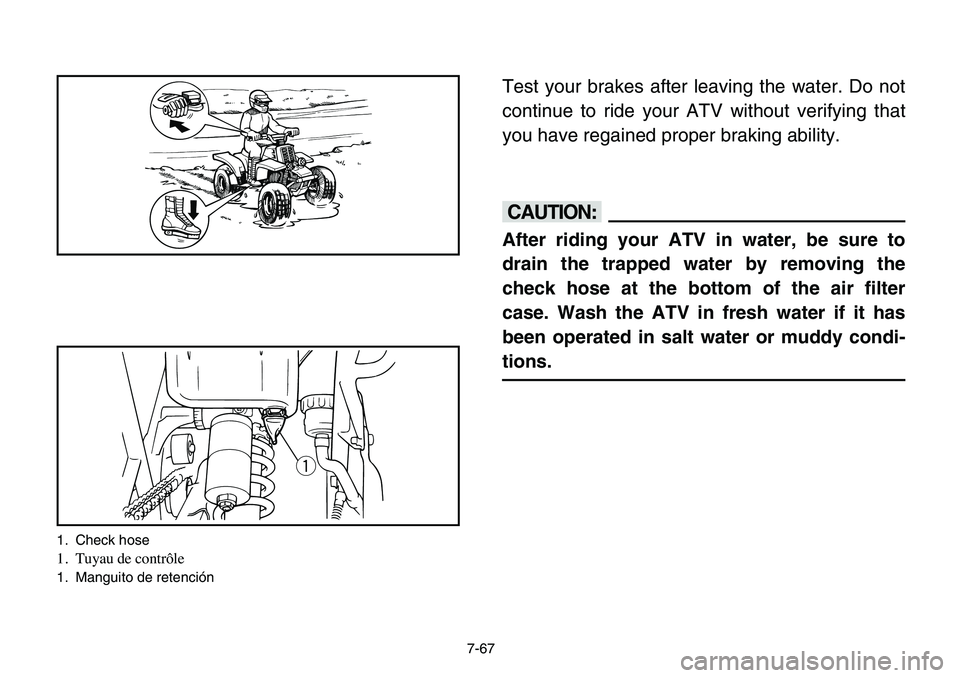
7-67
Test your brakes after leaving the water. Do not
continue to ride your ATV without verifying that
you have regained proper braking ability.
cC
After riding your ATV in water, be sure to
drain the trapped water by removing the
check hose at the bottom of the air filter
case. Wash the ATV in fresh water if it has
been operated in salt water or muddy condi-
tions.
q
1. Check hose
1. Tuyau de contrôle
1. Manguito de retención
Page 236 of 400
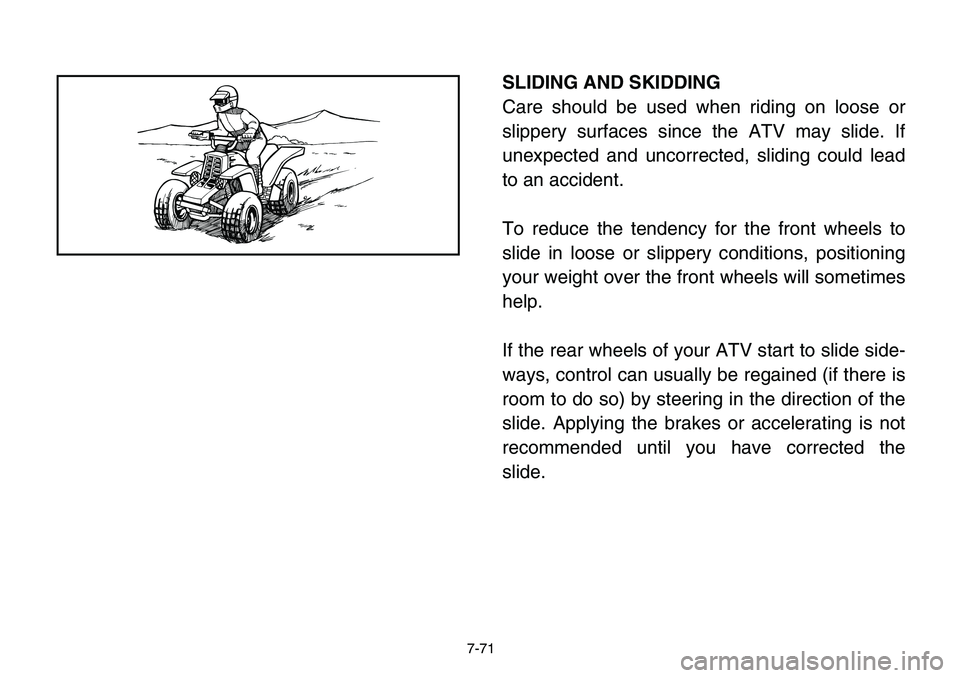
7-71
SLIDING AND SKIDDING
Care should be used when riding on loose or
slippery surfaces since the ATV may slide. If
unexpected and uncorrected, sliding could lead
to an accident.
To reduce the tendency for the front wheels to
slide in loose or slippery conditions, positioning
your weight over the front wheels will sometimes
help.
If the rear wheels of your ATV start to slide side-
ways, control can usually be regained (if there is
room to do so) by steering in the direction of the
slide. Applying the brakes or accelerating is not
recommended until you have corrected the
slide.
Page 242 of 400
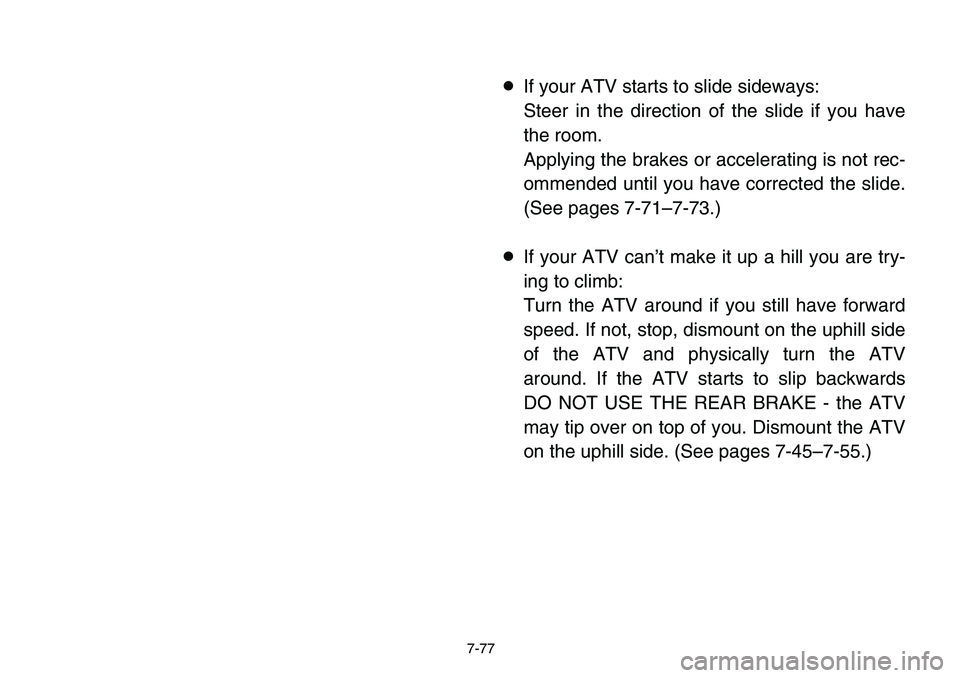
7-77
8If your ATV starts to slide sideways:
Steer in the direction of the slide if you have
the room.
Applying the brakes or accelerating is not rec-
ommended until you have corrected the slide.
(See pages 7-71–7-73.)
8If your ATV can’t make it up a hill you are try-
ing to climb:
Turn the ATV around if you still have forward
speed. If not, stop, dismount on the uphill side
of the ATV and physically turn the ATV
around. If the ATV starts to slip backwards
DO NOT USE THE REAR BRAKE - the ATV
may tip over on top of you. Dismount the ATV
on the uphill side. (See pages 7-45–7-55.)
Page 244 of 400
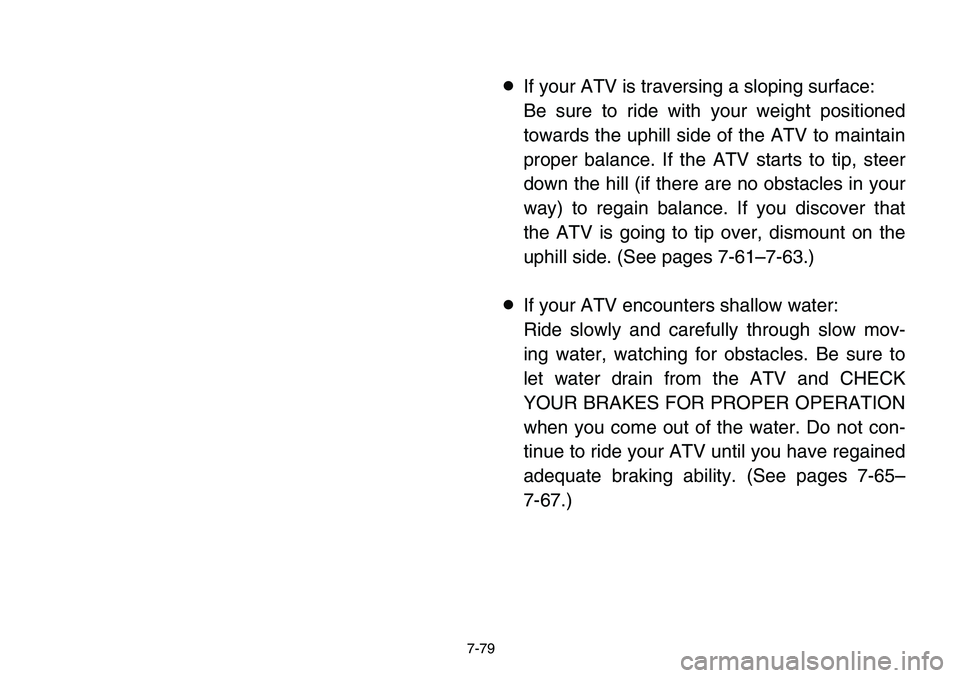
7-79
8If your ATV is traversing a sloping surface:
Be sure to ride with your weight positioned
towards the uphill side of the ATV to maintain
proper balance. If the ATV starts to tip, steer
down the hill (if there are no obstacles in your
way) to regain balance. If you discover that
the ATV is going to tip over, dismount on the
uphill side. (See pages 7-61–7-63.)
8If your ATV encounters shallow water:
Ride slowly and carefully through slow mov-
ing water, watching for obstacles. Be sure to
let water drain from the ATV and CHECK
YOUR BRAKES FOR PROPER OPERATION
when you come out of the water. Do not con-
tinue to ride your ATV until you have regained
adequate braking ability. (See pages 7-65–
7-67.)
Page 320 of 400
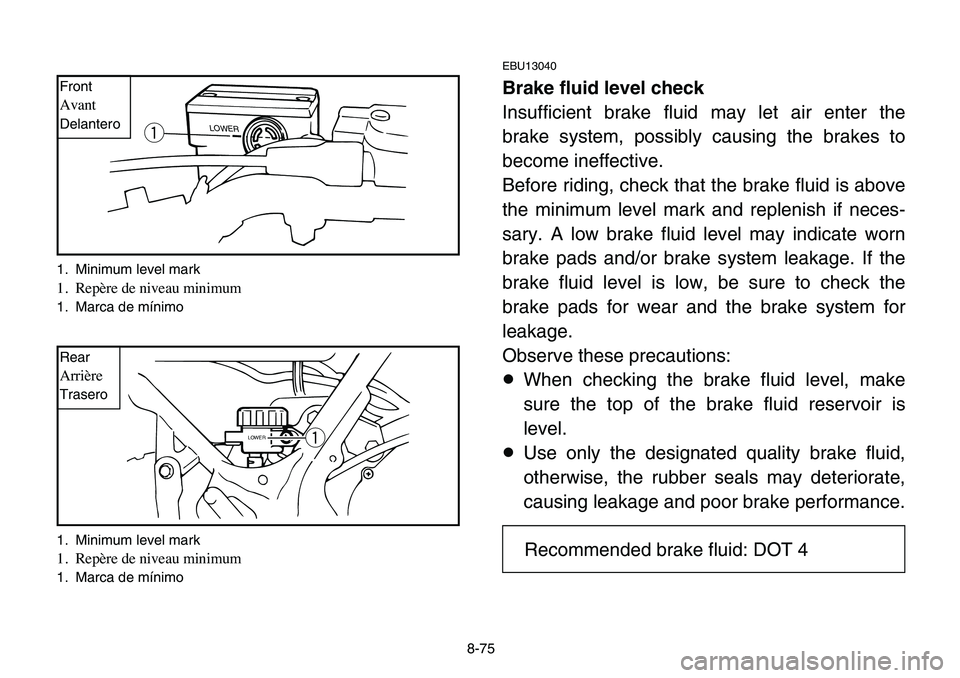
8-75
EBU13040
Brake fluid level check
Insufficient brake fluid may let air enter the
brake system, possibly causing the brakes to
become ineffective.
Before riding, check that the brake fluid is above
the minimum level mark and replenish if neces-
sary. A low brake fluid level may indicate worn
brake pads and/or brake system leakage. If the
brake fluid level is low, be sure to check the
brake pads for wear and the brake system for
leakage.
Observe these precautions:
8When checking the brake fluid level, make
sure the top of the brake fluid reservoir is
level.
8Use only the designated quality brake fluid,
otherwise, the rubber seals may deteriorate,
causing leakage and poor brake performance.
LOWERq
LOWERq
1. Minimum level mark
1. Repère de niveau minimum
1. Marca de mínimo
1. Minimum level mark
1. Repère de niveau minimum
1. Marca de mínimoFront
Avant
Delantero
Rear
Arrière
Trasero
Recommended brake fluid: DOT 4
Page 326 of 400
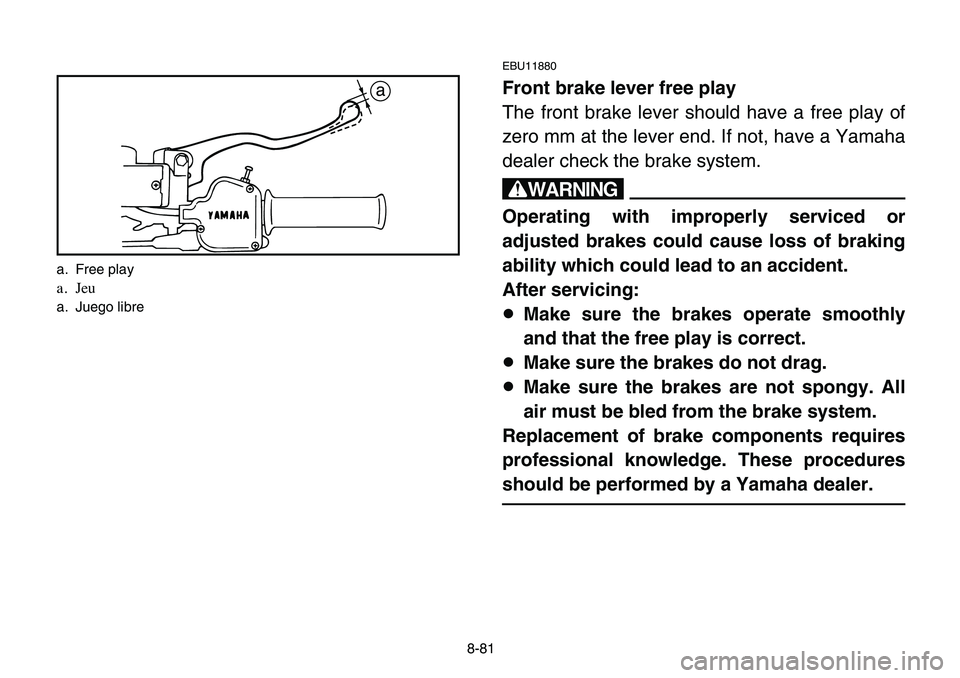
8-81
EBU11880
Front brake lever free play
The front brake lever should have a free play of
zero mm at the lever end. If not, have a Yamaha
dealer check the brake system.
w
Operating with improperly serviced or
adjusted brakes could cause loss of braking
ability which could lead to an accident.
After servicing:
8Make sure the brakes operate smoothly
and that the free play is correct.
8Make sure the brakes do not drag.
8Make sure the brakes are not spongy. All
air must be bled from the brake system.
Replacement of brake components requires
professional knowledge. These procedures
should be performed by a Yamaha dealer.
a
a. Free play
a. Jeu
a. Juego libre
Page 328 of 400
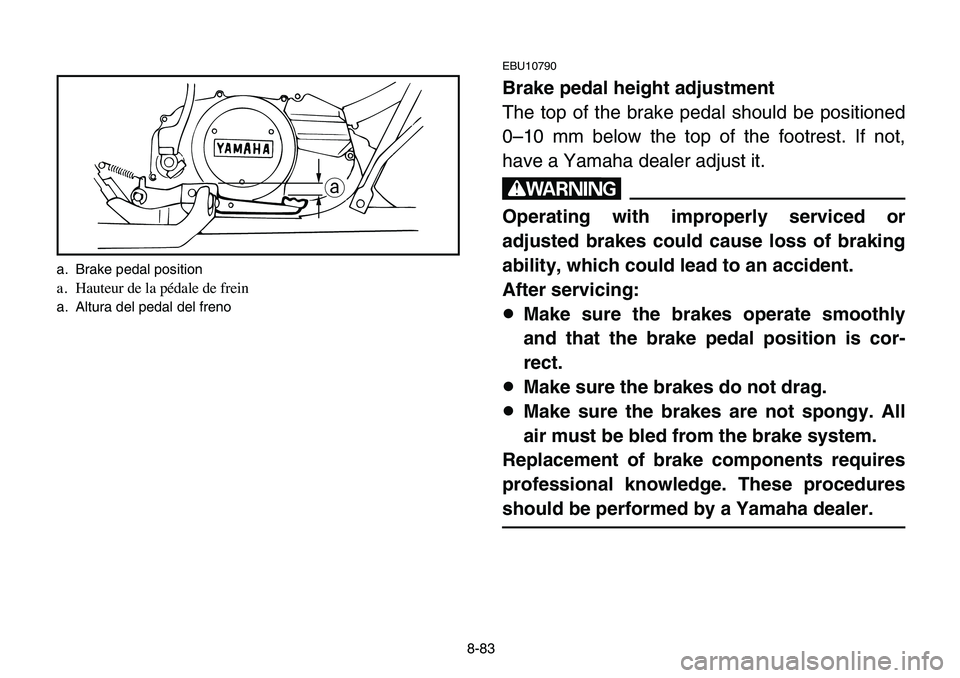
8-83
EBU10790
Brake pedal height adjustment
The top of the brake pedal should be positioned
0–10 mm below the top of the footrest. If not,
have a Yamaha dealer adjust it.
w
Operating with improperly serviced or
adjusted brakes could cause loss of braking
ability, which could lead to an accident.
After servicing:
8Make sure the brakes operate smoothly
and that the brake pedal position is cor-
rect.
8Make sure the brakes do not drag.
8Make sure the brakes are not spongy. All
air must be bled from the brake system.
Replacement of brake components requires
professional knowledge. These procedures
should be performed by a Yamaha dealer.
a
a. Brake pedal position
a. Hauteur de la pédale de frein
a. Altura del pedal del freno